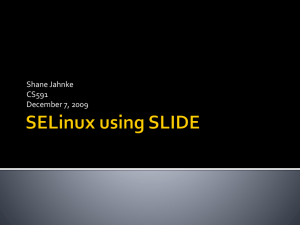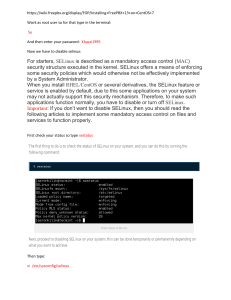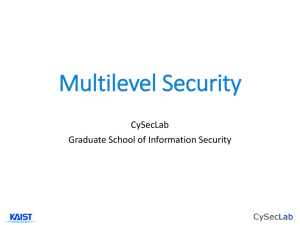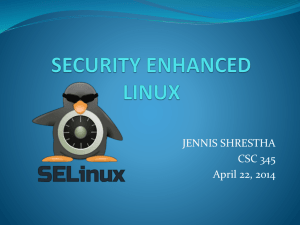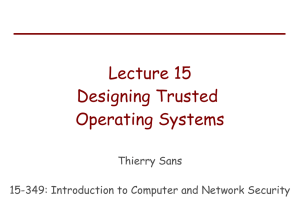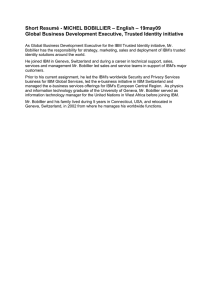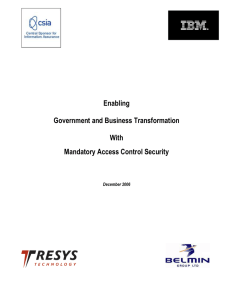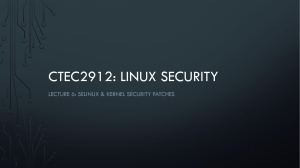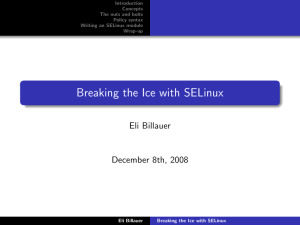Enabling Business through SELinux Doc Shankar IBM Distinguished Engineer
advertisement
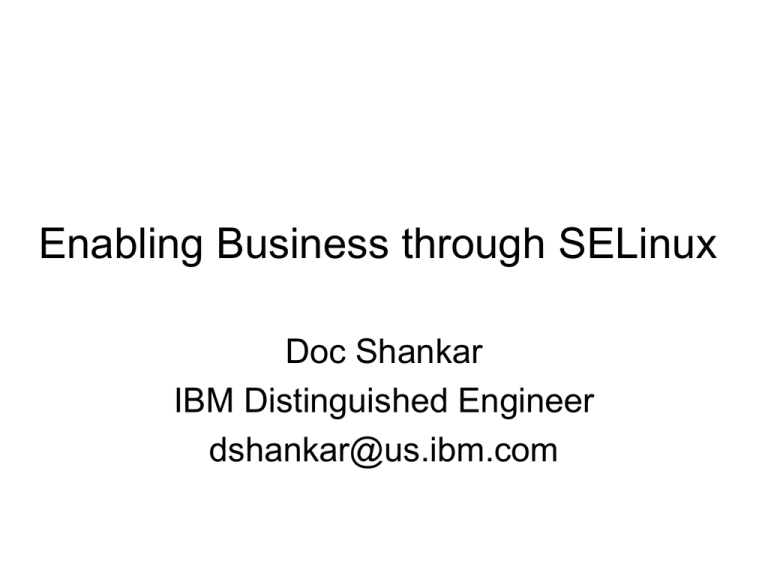
Enabling Business through SELinux Doc Shankar IBM Distinguished Engineer dshankar@us.ibm.com Agenda • • • • • • • • Basic Access Control Concepts SELinux Concepts SELinux based MLS/Linux (LSPP Certified) SELinux Value SELinux Prevented Exploits SELinux Solutions SELinux Today SELinux Tomorrow 2 Access Control Requirements • Reference Monitor – Concept arose from Anderson's report—research in early 1970s to address government computer security concerns. – Small security-enforcing mechanism is core of TCB. – Active entities—processes—are subjects. – Passive entities—system resources—are objects. – Both subjects and objects have security attributes. – The reference monitor consults rules to make decisions based on security attributes. – It typically logs decisions so actions can be audited. • 3 Fundamental Properties – Completeness – Tamperproofness – Correctness 3 4 DAC - Concepts • Traditional UNIX owner-group-other access control model and, optionally, ACLs • Two roles: superuser and ordinary user • Access to objects at owner’s discretion • Access mode can be modified by the owner or programs running on behalf of the owner • Enforcing mechanism and rules hard-coded in the kernel 5 MAC - Concepts • Derived from separation required by military environments • Administrator (and not the owner) has full control over allowed access • Programs running on behalf of a user are constrained by the administrator controlled security policy • Rules can be hard-coded in the kernel or configurable 6 DAC vs MAC Discretionary Access Control • Familiar, easy to understand • model used by most operating systems • users have control (discretion) over their files and programs • programs run as a user have that user's privileges • root/superuser has complete control • Trusted programs often run as superuser • attacker's goal is to exploit program running with root privileges • Superuser privileges harder to breakup Mandatory Access Control Newer concept, hard to grasp Not part of mainstream OS program privileges under the control of security policy easier to implement principle of least privilege supplements DAC Trusted programs privileges also under the control of security policy Attacker is contained Role separation Policy Kernel Kernel Enforcement Discretionary Access Control Once a security exploit gains access to privileged system components the entire system is compromised Mandatory Access Control Kernel policy defines application rights, firewalling applications from compromising the entire system 7 Domain-Type Enforcement (DTE) • Developed in 1980s by Boebert and Kain. • Subjects are in domains and objects have types. • Think of domains and types as equivalence classes for processes and resources, respectively. • Flexible and configurable policy implements MAC rules that mediate access between all domains and types. Very rich and granular. • Many MAC models can be expressed in terms of DTE. • Policies can be difficult to develop and analyze. 8 SELinux TE • Both domains and types implemented as types. Subject types are sometimes referred to as domains • Non-authoritative—DAC can deny first. • Default is to deny everything; policy specifies allows. • All objects receive context labels, via xattrs if possible. • Users are assigned a context upon login. • Each process transitions into its domain on exec. • The SELinux Security Server makes decisions on whether a domain can access a type by examining the context labels and consulting the policy • Security policy specifying MAC rules is configurable and can be changed dynamically • MAC rules are specified for subject domains, object types and object classes 9 TE – Access Control Example • Users Bob, Alice, Jack and Jill are part of a software development project • Upon login they are placed in domain proj_member_t • Project files are of type proj_files_t • The security policy allows subjects in proj_member_t domain read access to files of type proj_files_t proj_member_t read proj_files_t 10 TE/RBAC – Access Control Example • Alice, Bob and Jill are developers, Jack writes design documents, and Alice is also the project lead • Changing roles puts users in appropriate domains, for example, changing role to developer_r puts the user in domain proj_devel_t proj_doc_t proj_member_t read proj_devel_t proj_files_t proj_docs_t proj_lead_t 11 SELinux Overview • Created by NSA through series of research projects in the 1990s • Based on the Flask architecture developed by NSA, SCC, and University of Utah • Originally a huge kernel patch, which Linus disliked. • Led to creation of Linux Security Module (LSM) architecture. • Implemented as a set of LSM hooks. • Separates policy from implementation. • Flexible TE policy language is excruciatingly granular. • Orthogonal to DAC; non-authoritative-can only deny. • RBAC—roles aggregate types a user can take on. • MLS implemented as an additional constraint on the TE policy 12 SELinux Operation 13 Linux Meets Trusted Common Criteria Linux has been evaluated at EAL4+ against CAPP, LSPP and RBACPP Trusted evaluation completed June 2007 Available on Red Hat’s RHEL5 All IBM Server Platforms are evaluated for Trusted Linux Linux is now the most evaluated operating system LSPP evaluation includes more HW platforms than any other OS – Scale up, scale out Commoditization of government quality security – Cost savings for government – Government style security widely available Revalidation of open source development methodology 14 What does it take to get LSPP Certified at EAL4+? “Methodically Designed, Tested, and Reviewed” • • Community Development – – – MLS Policy Labeled Networking Labeled Printing – – Audit Enhancements Polyinstantiation Assurance – – – – Security Target: 106 pages Protection of TOE Security Functions (amtu) Configuration Management (CVS) Delivery & Operations: ~100 pages • – Development Documents • Common Criteria Effort • • • – Security Target Protection of TOE Config Mgmt Delivery & Operations FSP HLD LLD Other Dev Docs Guidance Docs Life Cycle Security Testing Vulnerability Assessment – Flaw remediation, security patch process Testing • • – User, Security & Admin Manuals Life Cycle • Functional Development Functional Specification: hundreds of man pages High Level Design: 271 pages Low Level Design: ~ 800 pages Security Policy Model: 11 pages Guidance Documentation: ~825 pages • – Install & Configuration Manuals Test plan 1200 test cases Vulnerability Assessment: ~ 50 pages 15 LSPP Community • A true open source effort - challenging • IBM sponsors a weekly teleconference (open telecon) – 60+ participants from 14+ organizations on the invitation • IBM, Red Hat, NSA, @sec, HP, TCS, Tresys, OSDL, and PSU + various individuals – All development takes place on open mailing lists • Development goes upstream and is collected in rawhide – Fedora Rawhide provides daily builds – Red Hat hosts test kernels for features pending kernel maintainer acceptance • Real users provide feedback during development • Schedule – In Evaluation (09/05) – Development Complete (03/07) – Certification Complete (06/07) 16 SELinux Value • • • • • • • • • • • • Designed by NSA to meet government security requirements now and in the future SELinux + MLS modifications accepted into the kernel SELinux is flexible—many different MAC models can be implemented in terms of it Restrictive Security (DAC + TE + MLS) Part of mainline OS – not an add-on Supported in RHEL 5 Meets Common Criteria Labeled Security Protection Profile (LSPP) MLS requirements at EAL4+ (Single cert. covers 7 platforms) Targeted (confinement) policy enabled by default in RHEL 5 Strict (least privilege) and MLS policies also supported Requires fewer specialized skills compared to special-purpose trusted OS's Has Open Source test suite to demonstrate LSPP compliance during C&A Mitigate the effects of common attacks that DAC cannot: – – • • • • • Trojan horse Buffer overflow Decompose root privileges. Extensively analyzed for correctness Free software – customers can inspect & maintain source code as necessary Draws a vibrant community including end customers Provides an alternative to Trusted Solaris. 17 SELinux Prevented Exploits* • NYSE http://james-morris.livejournal.com/30367.html • Firefox plug in protection http://danwalsh.livejournal.com/17727.html • Mambo code injection exploit blocked: http://www.linuxjournal.com/article/9176 • Open Pegasus stack buffer overflow https://rhn.redhat.com/errata/RHSA-2008-0002.html • HP Linux Imaging & printing erroneous input https://rhn.redhat.com/errata/RHSA-2007-0960.html • Samba Buffer overflow http://cve.mitre.org/cgi-bin/cvename.cgi?name=CVE-2007-2447 • Linux kernel local privilege escalation (0 day exploit) https://www.redhat.com/archives/fedora-selinux-list/2006-July/msg00071.html *Not a complete list (more on http://www.tresys.com/innovation.php) 18 SELinux based Solutions* • UK Government eCabinet office • US Coast Guard • Trusted Computer Solutions – Trusted Thin Clients – Trusted Guards • • • • • Tresys (WebSphere, DB2) NSA HAP MLS Applications (TNE) CDS Applications (Guards) Cross Domain SOA *Not a complete list 19 SELinux Today Confine Damage from Hacked Programs Precise Control Over Permissions DONE? SELinux RBAC Brickwall LSM MLS Linux LSPP semanage EAL4+ Modular policy Remove Dependence on Root setroubleshoot Limit User and Application Privileges Increasingly widespread deployment in public sector 20 SELinux Tomorrow SMB Market / Ease of Use Broader deployment Cross-OS Common Domain of Interpretation Standardizatio n DONE? NO “How do we turn it off?” SELinux RBAC Brickwall Enterprise Management Centralized Policy Mgmt LSM MLS ISV Policy Creation Linux LSPP semanage Policy Abstraction EAL4+ Modular policy Database Label Integration Application Level Security setroubleshoot Trusted X Windows Mandatory Encryption Policies Real-Time + SELinux Technology Horizon 21 Thank You! . . . Any Questions? 22 Trademarks and Presentation Notes • The following are trademarks of the International Business Machines Corporation in the United States and/or other countries. For a complete list of IBM Trademarks, see www.ibm.com/legal/copytrade.shtml: eServer, System x, System p, System i, System z, IBM. • • The following are trademarks or registered trademarks of other companies: Java and all Java based trademarks and logos are trademarks of Sun Microsystems, Inc., in the United States and other countries or both Microsoft, Windows,Windows NT and the Windows logo are registered trademarks of Microsoft Corporation in the United States, other countries, or both. Linux is a trademark of Linus Torvalds in the United States, other countries, or both. Red Hat, Red Hat Linux are registered trademarks of Red Hat, Inc. SUSE is a registered trademark of Novell, Inc. Other company, product, or service names may be trademarks or service marks of others. • • • • • • Any statements about support or other commitments may be changed or cancelled at any time without notice. All statements regarding IBM's future direction and intent are subject to change or withdrawal without notice, and represent goals and objectives only Information is provided “AS IS” without warranty of any kind. • This publication was produced in the United States. IBM may not offer the products, services or features discussed in this document in other countries, and the information may be subject to change without notice. Consult your local IBM business contact for information on the product or services available in your area. • Information about non-IBM products is obtained from the manufacturers of those products or their published announcements. IBM has not tested those products and cannot confirm the performance, compatibility, or any other claims related to non-IBM products. Questions on the capabilities of non-IBM products should be addressed to the suppliers of those products. • The information could include technical inaccuracies or typographical errors. Changes are periodically made to the information herein; these changes will be incorporated in new editions of the publication. IBM may make improvements and/or changes in the product(s) and/or the program(s) described in this publication at any time without notice. • Any references in this information to non-IBM Web sites are provided for convenience only and do not in any manner serve as an endorsement of those Web sites. The materials at those Web sites are not part of the materials for this IBM product and use of those Web sites is at your own risk. • IBM makes no representation or warranty regarding third-party products or services including those designated as ServerProven, ClusterProven or BladeCenter Interoperability Program products. Support for these third-party (non-IBM) products is provided by nonIBM Manufacturers. • IBM may have patents or pending patent applications covering subject matter in this document. The furnishing of this document does not give you any license to these patents. Send license inquires, in writing, to IBM Director of Licensing, IBM Corporation, New Castle Drive, Armonk, NY 10504-1785 USA.
